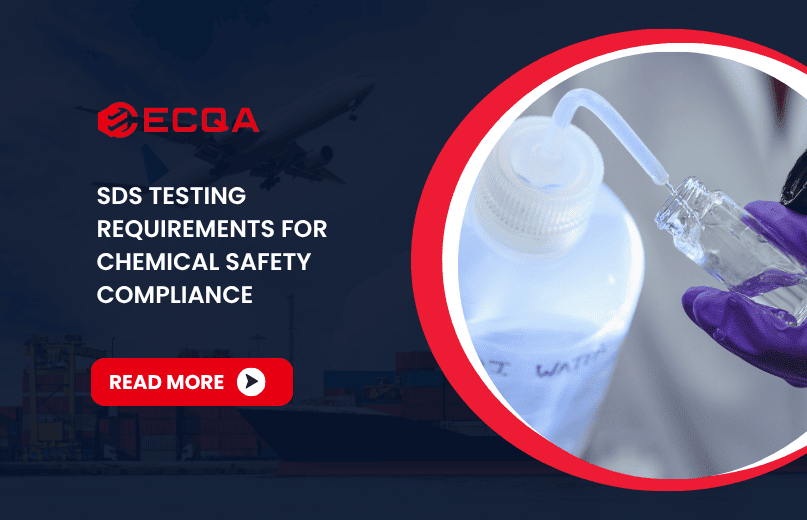
SDS Testing Requirements for Chemical Safety Compliance
A Safety Data Sheet (SDS) is a legally required document that outlines critical information about a chemical substance or mixture. It provides manufacturers, importers, distributors, and end-users with essential details about hazards, handling procedures, storage guidelines, disposal practices, and emergency measures.
SDS documentation is governed by regulations such as OSHA’s Hazard Communication Standard (HCS) in the United States, REACH in the European Union, and GHS (Globally Harmonized System) internationally. The SDS acts as the cornerstone of chemical safety compliance and hazard communication across the entire supply chain.
Any entity placing chemical products on the market must ensure their SDS is complete, accurate, and compliant with regional standards. SDS testing is not about testing the physical sheet itself, it involves a thorough review, verification, and validation of the safety data to ensure it aligns with up-to-date scientific assessments, standardized classification systems, and legal obligations.
Why SDS Testing is Essential

Incorrect or outdated information on an SDS can trigger serious legal, safety, and financial consequences, including import refusals, recalls, penalties, or liability in the case of incidents. Proper SDS testing enables:
- Regulatory compliance across jurisdictions (e.g., OSHA, REACH, WHMIS)
- Hazard classification consistency based on chemical composition and lab results
- Worker safety by ensuring accurate labeling and instructions
- Global market access through alignment with international standards
- Third-party verification to confirm technical accuracy
From a compliance standpoint, regulators expect SDSs to be updated every time there is a new hazard classification, substance re-evaluation, or changes in the regulatory framework. Without professional SDS testing, many businesses unknowingly distribute non-compliant documents that fall short of legal standards.
Key SDS Testing Components and Technical Requirements
1. Substance Identification and Composition Testing
This section ensures the product is properly identified and classified. SDS testing involves analyzing the chemical name, CAS number, EC number, and percent composition. Mixtures must reflect accurate percentages and roles of ingredients, especially those classified as hazardous.
Typical testing requirements include:
- Purity and impurity analysis
- Confirmatory analytical methods (e.g., GC-MS, HPLC)
- Component identity verification
2. Hazard Classification Testing
A product’s hazard class and category must be defined according to GHS criteria. Lab testing validates properties like:
- Flammability
- Explosivity
- Toxicity (oral, dermal, inhalation)
- Corrosivity and irritation
- Environmental hazards (aquatic toxicity)
Classification outcomes are used to assign appropriate signal words, pictograms, hazard statements, and precautionary statements.
3. Physical and Chemical Property Testing
These parameters must be laboratory-verified to ensure they match the SDS. Examples include:
- Boiling point
- Melting point
- Flash point
- Auto-ignition temperature
- pH value
- Vapor pressure
These metrics are foundational for safe handling, storage, and transport. A mismatch in reported vs. tested values is a common reason for regulatory rejection.
4. Stability and Reactivity Testing
Testing under controlled environments assesses whether the product is chemically stable or reactive under certain conditions. It includes:
- Decomposition temperatures
- Reactivity with water, acids, or air
- Incompatible materials
- Possibility of hazardous polymerization
This section supports emergency response preparedness and safe material segregation.
5. Toxicological and Ecological Information Verification
Data used for health hazard classifications should be backed by toxicological test reports:
- LD50 and LC50 values
- Sensitization and irritation studies
- Reproductive toxicity evaluations
- Bioaccumulation and degradation profiles
Where proprietary or REACH-registered data are used, cross-referencing and verification through qualified databases is essential.
6. Labeling and Communication Consistency
Testing ensures that the SDS content is fully aligned with the product label. All hazard pictograms, precautionary statements, and hazard codes must be synchronized. Discrepancies between SDS and labels often lead to shipment holds or fines.
7. Regulatory Reference and Section Review
SDS must reference the appropriate legislation and standards. Each of the 16 mandatory SDS sections (under GHS) must be reviewed for:
- Format consistency
- Section completeness
- Use of standardized terminology
International Regulatory Frameworks Governing SDS Testing
OSHA Hazard Communication Standard (HCS)
In the United States, OSHA mandates that all chemical manufacturers and importers prepare SDSs that meet GHS-aligned standards. SDS must be in English and accessible to employees.
REACH Regulation (EU)
REACH requires detailed information on the composition, toxicology, and safe use of substances manufactured or imported into the EU above 1 ton/year. The SDS must align with REACH Annex II.
CLP Regulation (EU)
This regulates the classification, labeling, and packaging of substances. SDS classifications must reflect CLP alignment for European compliance.
GHS (Globally Harmonized System)
Used as the international standard, GHS provides the framework for SDS formatting, hazard classification, and label elements across markets including ASEAN, China, Korea, Japan, and Australia.
WHMIS (Canada)
Canada’s system integrates GHS with specific labeling and SDS requirements under the Hazardous Products Act.
Each region has subtle differences in implementation. A globally valid SDS must be adapted to each market’s format, language, and regulatory expectations.
Who Needs SDS Testing Services
- Chemical manufacturers preparing to launch new products
- Exporters or importers dealing with cross-border regulations
- Private label brands sourcing raw materials globally
- Laboratories and distributors repackaging hazardous materials
Any company with chemical substances in their portfolio has a legal and ethical duty to provide validated SDSs.
Non-compliant Safety Data Sheets are a silent liability that can damage your operations, reputation, and global access. Chemical safety compliance begins with properly tested, verified, and formatted SDS documentation.
Partner with a qualified SDS testing service like ECQA to protect your business, meet legal obligations, and confidently navigate international markets.

 Request Free Sample Report
Request Free Sample Report